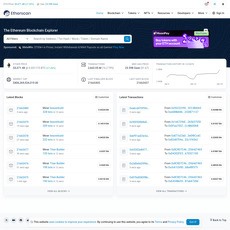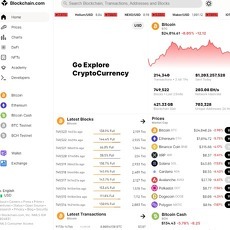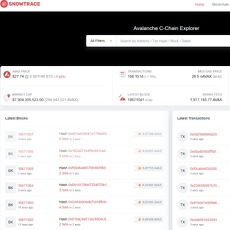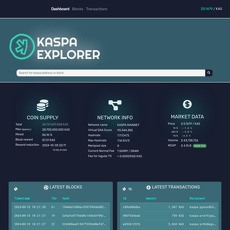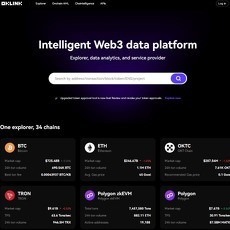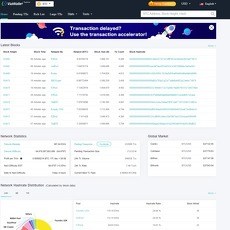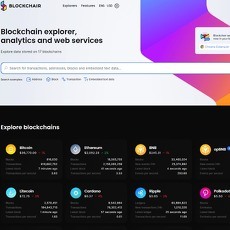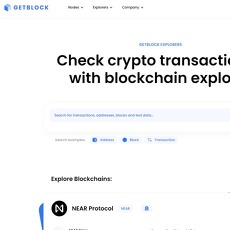Best Blockchain Explorers - Blockchain Network Search Engine
Blockchain Explorers Sites
If you have ever wanted to enter the world of cryptocurrencies, the chances are high that, at some point, you might have become curious as to how they work on the back end and how all of the data gets recorded on a public ledger.
Blockchains are, by design, enormous public ledger databases that allow suitable options when it comes to navigating them as a whole. However, it can be difficult for an individual without much technical know-how to utilize a blockchain application.
This has led many to question how any individual without any prior expertise or knowledge in various programming languages can explore the blockchain without needing to undergo many difficulties.
Cryptocurrency owners have utilized blockchain explorers as the answer to this, which has allowed them to check the status of sent and received transactions.
Keep in mind, though, that blockchain explorers typically have a lot more use-cases, and serve the role of a search engine for the blockchain, similarly to how we utilize search engines such as Google, for example, to browse the web.
With the growing adoption of blockchains, more people than ever before want to access some of the most popular blockchain networks and can do so through the utilization of the blockchain explorer.
Blockchain explorers serve the role of being an essential tool that allows anyone to look up their transactions on the blockchain and provide different information about transactions, such as the date, incoming address, outgoing address, fees, amount, block height, total size, and so on.
By far, the best thing surrounding blockchain technology is the fact that it offers a full level of transparency, as each of the transactions gets stored on an open-source blockchain record which is available 24/7 to anyone, at any time, from anywhere in the world.
As such, this piece is intended to give you an introduction to some of the technicalities found within blockchain explorers' sites. Once we go over everything here, you will be able to make a well-educated decision when it comes to picking the blockchain explorer that's best for you as quickly and as reliably as possible.
With all of this in mind, hopefully, by the end of this analysis and overview of blockchain explorer websites, you will be able to have a clear level of understanding when it comes to everything you need to know about the best blockchain explorers sites, and you can know what to look for in each option which will be available to you, which will let you keep track of just about everything that occurs on top of a specific blockchain that you are interested in exploring.
What are Blockchain Explorers Sites?
Blockchain explorer sites are websites that specialize in the procedure of allowing individual users access to a blockchain explorer.
Defining what a blockchain explorer actually is and what it represents is one of the best ways through which anyone can understand what these sites represent and how they can be utilized.
A blockchain explorer is essentially a blockchain network search engine.
For example, if someone wanted to access data surrounding the Bitcoin (BTC) blockchain network, they could utilize a blockchain explorer website and gain access to data surrounding specific transactions as well as wallet addresses on top of the blockchain.
Furthermore, they could gain access surrounding the hash rate, the difficulty, the block height, wallet addresses, transaction data, balance history tickers list, and just about anything else that they might be interested in learning surrounding the network.
The blockchain explorer is defined as the search engine that can display information about the history of a specific blockchain, as well as its current condition. A blockchain explorer is utilized as a means of easily observing all of the transactions that are available on top of the public blockchain network.
How do Blockchain Explorers Sites Function?
Blockchain Explorers were created to serve a specific purpose; in other words, each one of them aims to accomplish the goal of making it easy for someone to retrieve data that gets stored on top of a blockchain as a result of the consensus mechanism, which is utilized for the specific blockchain in question.
Anyone with access to a blockchain explorer is provided with the opportunity to view transactions as well as public addresses or even search for a block on the specific blockchain in question through the utilization of an explorer. By doing so, each one of them can get access to an update on the current status of the transactions and look within the transaction history of the individual currencies through the usage of these tools.
Anyone will also be able to search and even see the Bitcoin (BTC) transaction history, for example, of any wallet address, by leveraging the power of a blockchain explorer, which will enable a higher level of openness and transparency to the broader blockchain. Furthermore, this allows users to receive and update their addresses.
As an additional benefit to obtaining the transaction address, users can also view the altered address, which is a return of crypto to the sender, which helps keep the costs associated with transactions low.
Users of a blockchain explorer can also look into the day's most significant trader, for example, but remember that each blockchain explorer website will slightly vary in terms of what kind of data it showcases and how all of it is formatted.
Additionally, it is also a possibility to see all of the pending transactions within a memory pool through the usage of an explorer, also known as a mempool.
These transactions, ones that are awaiting confirmation by the miners within the network, assuming it is a Proof-of-Work (PoW) consensus network, are a representation of the fees which are paid to the network. Prior to completing a transaction, it is also helpful to know how busy the network is and how much the costs associated with using it are.
Some blockchain explorers will even dive deeper into the blockchain and believe that they can provide the opportunity to determine how many transactions are performed twice on a specific blockchain, and others can even let users look for orphaned blocks. Even though they were actually mined, these are blocks that are not linked to the longest blockchain, which makes it impossible to determine their origin. The initial block of a specific chain can also be found using an explorer, and this is why they are so popular.
The Different Types of Blockchain Explorers Sites Operations
Getting a solid level of understanding of the different types of blockchain explorer operations is an essential aspect of understanding how to use them.
This means that each user needs to understand what they are, how they work, and why they play an essential role in the broader blockchain ecosystem. Learning about these blockchain explorers can be an interesting experience for anyone just getting into the world of cryptocurrencies.
Alongside providing users with access to the number of transactions, the volume, the price, as well as the predicted hash rate shown on a daily basis, some charts and explorers can even showcase the price as well as the size of the overall mempool. We will be looking at a typical blockchain explorer's interface in order to showcase what it truly has to offer.
- Price data - the explorer's portal features a pricing section that will display several marketplaces which are compiled within a USD price feed. The price is determined by the feed's source, which is not referenced directly towards market rates.
- Transactions - The blockchain explorer represents a portal where the transactions are a snapshot of the ones that occurred throughout the span of the past 24 hours, which features unique transactions. In order for a transaction to be verified, it has to be included within a block that has been verified.
- Assumed Hash Rate - as you dive deeper into a blockchain explorer, you can get access and see the predicted computational resources that blockchain miners will typically employ. This expected hash rate and gauge security within a Proof-of-Work (PoW) consensus-based network, for example.
- Size of the overall mempool - one of the most significant components when it comes to learning how to utilize blockchain explorers is learning about the size of the overall mempool. This way, the size of the mempool is a proxy for the activity on the blockchain. It is a demonstration of the costs associated with expediting transaction confirmations.
- Amount of funds actually spent - throughout a span of 24 hours, blockchain transactions will verify a specific amount of outputs. The unspent outputs also get added to the overall volume of transactions which gets returned to the spending wallet as charged.
- The volume of transactions that are anticipated - Furthermore, an estimate of the actual amount of transactions that are sent between wallets are known as transaction volume. Transaction value minus predicted outputs returns as charge in the estimated transaction volume.
- The most recent block - the most recent blocks are essentially one of the essential considerations to look into whilst utilizing a blockchain explorer. Block explorers can aid through the process of displaying verified blocks within a chronological order, from the most recent to the oldest, and showcase information about the blocks, including data surrounding their timestamp, size, heights, as well as additional info, all of which can be analyzed from the functionality.
The evolution of Blockchain Explorers Sites
Blockchain Explorers were created due to the requirement surrounding the ability to view and read detailed data about transactions as well as for the ability to ensure a high level of transparency when it comes to transactions within a blockchain network.
Explorers enable reading of blockchain data history and wallet balances and are typically utilized as a means of confirming the status of a transaction and verifying if it has actually been confirmed. Blockchain explorers can also identify the mining pools that mine a given block, its block heights, orphaned blocks, and genesis blocks.
A blockchain explorer will typically provide each user with access to any activity that occurs on top of a blockchain network. This means that users can utilize the block explorer as a means of tracking the status of a pending transaction or viewing the balance of a wallet that they hold without needing to use the cryptocurrency wallet directly.
Over the years, blockchain explorers have evolved with the capabilities of the underlying blockchains as well.
Today, users can examine the history of any wallet address, such as all of the transactions sent to and from those addresses, and explore change addresses, which are transaction outputs that return coins to the sender in an effort to prevent too much of the input being spend throughout transaction fees and even view blocks which aren't events attached to the main blockchain. These are the ones whose parent blockchain is unknown.
Each user can also explore the largest transaction that was sent within the span of 24 hours and explore the number of double-spend transactions that have occurred on the blockchain. They can even discover the individual or mining pool that has mined a specific block and explore the genesis block, which is the first block that was mined within a given blockchain.
They did not end here with the evolution; however, today, users can see other information specific to a blockchain, including the average transaction fees, hash rate, mining difficulty, and other data.
There are now numerous more advanced use cases for block explorers, but it is important to remember that these are mostly utilized by companies that create sophisticated software solutions and aim to predict cryptocurrency prices, for example.
Today, here is how a blockchain explorer is typically utilized.
- Blockchain explorers utilize application programming interfaces (APIs), relational databases, and SQL databases alongside a blockchain node as a means of retrieving information from a specific network.
- Afterward, the software can organize the data into a database, where it displays things in a format that is searchable.
- The explorer can then be utilized to perform searches through an organized table in response to a user's demand by utilizing a simple user interface, such as a search engine, that will allow people to conduct searches.
- The explorer server can then create a web page through which it can interact with users, and an API will also allow the explorer to interface with other computers.
- Then, the search requests are sent to the backend server, which then responds to the user interface.
- Last but not least, the user interfaces, as well as the API, sends web pages in HTML format to the browser of the user so that the results can be read in a way that is easy to understand.
You can think of blockchain explorers as search engines that are utilized for blockchains, which allow users to find a lot of different types of information about anything and everything that occurs on top of a blockchain network.
All users have to do in order to utilize blockchain explorers is to visit blockchain explorers sites and enter the information they are looking for. To look up a pending transaction, for example, which is stored in the Mempool, they need to enter the transaction hash ID which is provided by the wallet or exchange.
A Blockchain Explorer Explained
When it comes to the functionality surrounding blockchain explorer, it is important to understand that each blockchain explorer functions by the utilization of a database that holds the entire blockchain in a searchable format and tables.
An explorer can work in a node interface to first extract all of the data within a given blockchain. Once it ends up deriving the data, it can then store it in a format that is easily searchable by utilizing the power of tables.
This means that it can gather the latest transactions, as well as the blocks, and then arrange them in accordance with the defined searchable categories. This includes wallet addresses, transaction identifiers, balances, and so on.
Furthermore, a blockchain explorer can also provide an interface through which the user will be able to search for the information, in a similar way to how we utilize Google to search for websites or YouTube to search for videos. The main goal here for the explorer is to make all of this as smooth as possible for the user.
However, when we look at it from a technological aspect, an explorer can use a relational database, an Structured Query Language (SQL) database, or even an Application programming interface (API).
- Structured Query Language (SQL) - this is essentially a protocol as well as a format that is utilized as a means of providing a query for a searchable database. For example, the software can create a table in the database, insert new records on the table and search the term, after which it can create a new table of results and then present the results on a web page to the person that is searching.
- Application programming interface (API) - this is essentially a protocol that allows users to communicate with machines through the utilization of software, where they define the criteria, format, and interactions for sending as well as receiving responses by the software that is used by the user.
Each blockchain consists of many distributed nodes. Each of these nodes can directly read the data within a blockchain network, after which it can grab the details of the latest transaction as well as mined blocks alongside other types of data. This then gets sent to the database, where the data gets arranged in the form of a searchable table.
This essentially makes an explorer fast to utilize, and most blockchains typically utilize 24 tables, such as block, address, transaction, and so on. Each of the rows within this database contains a unique ID or key, which is a unique identifier for addresses used on the blockchain. Others create a unique key by themselves in some cases.
The user interface utilized for the explorer in the form of a server can then create a web page that allows it to interact with a user through the way of a letter input of searchable terms.
This also provides an API to interface with other computers, and these then get sent to the backend server in a format that is server-readable, after which the backend server responds to the user interface server for the search terms.
The user interface, as well as the Application programming interface (API), then sends the web pages as Hypertext Markup Language (HTML) to the browser as a means of allowing the reading of responses from the user.
A relational database essentially allows for the storage of data components in a table, such that they are related to one another, and this, in turn, leads to a simplification of the management of data. What this essentially means is that instead of having a large block table that contains all of the details for each block, the block table entries can be linked to an entry in a header table.
Why Blockchain Explorers Sites have grown in popularity
Alongside all of the aforementioned benefits of using a blockchain explorer, there are a variety of activities each user can perform. In fact, the blockchain explorer can be utilized in numerous other ways, and it is due to this reason that they have blown up in popularity.
Through the usage of blockchain explorers, each user is provided with the opportunity to see all of the transactions which have occurred at a specific wallet address, and they might even make it a possibility for consumers to check the authenticity of a specific wallet address whilst also enhancing blockchain transparency.
Furthermore, blockchain explorers can be utilized as a means of observing the most recent transaction history, where users can see the transaction's receiving address and even change the address.
The use of a change address can play a major role when it comes to ensuring that the transaction fees do not get an excessive amount of input value, where they are boosting the transaction transparency.
Furthermore, there are several benefits that blockchain explorers can provide and identify the most significant transactions.
In other words, a blockchain explorer can be utilized as a means of studying the specifics surrounding a blockchain's transactions that have not been confirmed. Unconfirmed transactions can be accessed utilizing the Mempool Status.
Stale blocks with validated parent sources can also be found through the utilization of blockchain explorers, even if there is no connection to the longest chain.
Furthermore, orphaned blocks are another typical use case for blockchain explorers, where a block can be considered orphaned if it has no known parent blockchain.
It is also fully possible to employ these blockchain explorers as a means of finding instances of a "double spend" transaction that might have occurred on top of the network, and they even let users see transaction fees with the difficulty of the blockchain alongside other information.
Most importantly, blockchain explorers can also contribute to the process of discovering the genesis block, which forms the basis of a blockchain. The first block that is generated on top of a specific chain can be readily accessed, alongside the miner's name as well as other relevant information.
Benefits of Blockchain Explorers
There are a variety of different benefits found within the utilization of blockchain explorers. Here are just some of the main benefits that each user gets at the point in time that they decide to fully utilize the power found within blockchain explorer sites.
Each user of a blockchain explorer can check the balances as well as the expenses of innovative contract addresses, which can provide them with access to a higher level of transparency as users of blockchain explorer.
Before they transmit cryptocurrencies to someone, each user can utilize a blockchain explorer to check if the wallet address that they are transferring cryptocurrencies to is actually legitimate.
Furthermore, each user is also provided with the opportunity to verify that the transaction has been sent to the intended recipient through the usage of a blockchain explorer, and this means that it essentially fills the role of being proof to the public that a user has actually engaged in business with the person that they are connecting to. Furthermore, the blockchain explorer can also let users check their wallet balances at any point in time.
Alongside all of that, blockchain explorers can clarify the differences in transactions and how they have been processed or even verified, which can lead to an assist in determining if any issues have occurred throughout the verification stages that are a part of a blockchain's consensus mechanism.
Wallets and other software developers can also gain benefits from the input of block explorers by determining what additional features, as well as functionalities, are a requirement, and they can verify that their wallets are transmitting, receiving, and keeping their cryptocurrency as they are programmed to do so.
This means that a blockchain explorer can be a valuable tool when it comes to determining whether or not to make future investments in computer resources and even support activities involved with mining.
Are Blockchain Explorers Sites legal in your country?
Given the fact that cryptocurrencies have exploded in terms of their popularity on a global scale, a lot of people started gaining genuine interest when it comes to exploring everything that they have on offer.
Due to their widespread appeal and adoption rate, many countries have already established the legal groundwork surrounding cryptocurrencies. What this means is that the region you reside in should have some type of documentation in regards to this topic.
However, exploring a blockchain network is not the same as buying, selling, or trading a cryptocurrency. Users are not even mining cryptocurrencies, and all they are essentially doing is exploring the data that is available across a blockchain network.
What this essentially means is that blockchain explorer sites should be fully legal in almost every country out there. However, it is always recommended to double-check this in the specific part of the world that you reside in.
Do Blockchain Explorers Sites offer a solid user experience?
Most of the time, blockchain explorers' sites will feature their own unique website and user-design elements as a means of teaching the user as much as possible in regards to how they can explore and utilize the blockchain explorer to its maximum possible potential.
Once you end up visiting many of these websites, as a user, you will be greeted by numerous animations alongside data surrounding each and every package available. This means that you should be able to see various information, including:
- How you can create an account.
- How you can access a specific blockchain explorer.
- A full list of the blockchain explorers that are available, as well as the cryptocurrencies.
- A full list of all of the instructions or commands you need in order to connect to the specific blockchain explorer in question.
Furthermore, each of these websites will typically provide you with what kind of connection they are using as a means of establishing a connection to the blockchain node in question, as well as the uptime that they promise.
Do Blockchain Explorers Sites offer advanced information surrounding each package?
When it comes to blockchain explorer websites, they provide users with information about everything they need to know in order to connect to and fully utilize the blockchain explorer in question.
Many people who are utilizing blockchain explorers for the very first time are likely to have little to no prior experience in the field, and as such, a blockchain explorer service provider will need to educate people as much as possible. This is why you will find a lot of educational content in the form of a blog post or a video on a lot of service providers that take an in-depth look at everything you need to know surrounding the use cases of blockchain explorers.
In other words, the answer to this question is an absolute yes, as a majority of blockchain explorer sites do indeed offer advanced information surrounding each of the packages that are available, where they go in-depth surrounding their pricing plans as well.
What level of security do Blockchain Explorers Sites implement?
There is a high level of security surrounding blockchain explorers due to the fact that the blockchain itself, the public ledger that you are viewing, is secured by the underlying blockchain technology. All blockchain explorers do is keep things online and provide you with access to all of that data which is secured, and as such, you are essentially gaining access to blockchain explorers, which feature the best level of security possible and are enabled by blockchain technology.
Do Blockchain Explorers Sites have native cryptocurrencies?
Blockchain explorer sites will not feature their own native cryptocurrency, and this is due to the fact that they fill the role of being the middleman between you and the underlying public ledger that you are trying to access.
Each blockchain that you end up exploring will feature its own native cryptocurrency. For example, Bitcoin has BTC, Ethereum has Ether or ETH, Cardano has ADA, Solana has SOL, and many other blockchains feature their own native cryptocurrency.
However, the explorer that you will be utilizing as a means of accessing them will not have its own native cryptocurrency.
You can view blockchain explorer sites as your gateway towards accessing all and any available blockchain data that you require for whatever reason, be it for trading, sending cryptocurrency from one wallet to another wallet, confirming that a wallet exists, or even for your decentralized application (dApp) development process.
What this results in is the fact that there is not a blockchain explorer site that features its own native cryptocurrency that has utility associated with it, but each underlying blockchain that you will explore with the blockchain explorer will feature its own native cryptocurrency.
What users should look out for prior to engaging with Blockchain Explorers Sites
There is a plethora of information surrounding blockchain explorer sites that you will be easily able to find. However, there are a few key things that you need to keep in mind.
There are free blockchain explorers as well as paid blockchain explorers. Each blockchain explorer will typically utilize a different way through which users can connect to it, although a majority of the data will be similar.
Some blockchain explorers dive a lot deeper when compared to others and provide users with data that is unique to their service and cannot be found anywhere else.
It is always advisable to do your own due diligence and research prior to engaging with a blockchain explorer site and ensure that it can provide you with all of the valuable data that you require in order to get what you need at the point in time when you actually need it. There are numerous blockchain explorers sites available, and each of them features its own pros and cons, so it is up to the user to verify which website or solution as a whole they feel the most comfortable with using.

